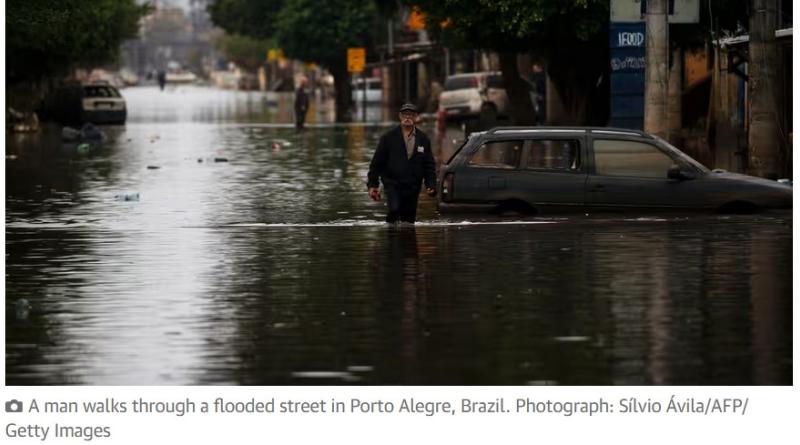Devastating Brazil floods made twice as likely by burning of fossil fuels and trees

The unusually intense, prolonged and extensive flooding that has devastated southern Brazil was made at least twice as likely by human burning of fossil fuels and trees, a study has shown.
The record disaster has led to 169 deaths, ruined homes and wrecked harvests, and was worsened by deforestation, investment cuts and human incompetence.
The team of international scientists behind the study predicted that calamities on this scale – the worst to hit the region – would become more common in the future if there was not a sharp reduction in the greenhouse gas emissions heating the planet.
Hundreds of thousands of people in the state of Rio Grande do Sul and in nearby Uruguay are still trying to rebuild their lives after a month of persistent downpours that displaced 80,000 people and left more than a million without essential services such as electricity and potable water.
During the peak of the rains on 1 May, the city of Santa Maria set a 24-hour rainfall record of 213.6mm. In just three days, the state capital, Porto Alegre, was inundated with two months’ worth of rain, transforming roads into rivers, football stadiums into lakes and damaging the city’s international airport so badly it remains closed.
The economic cost is expected to exceed $1bn (£780m) and the dire impact on agriculture is expected to raise prices of rice – Rio Grande do Sul usually produces 90% of Brazil’s crop – and dairy products across the country.
The region’s focus on agriculture has come at a high cost. The authors of the study said that in recent decades, natural flood defences such as riverside forests and marshes have been cleared for fields, often in violation of weakly enforced environmental regulations.
The unusually intense, prolonged and extensive flooding that has devastated southern Brazil was made at least twice as likely by human burning of fossil fuels and trees, a study has shown.
The record disaster has led to 169 deaths, ruined homes and wrecked harvests, and was worsened by deforestation, investment cuts and human incompetence.
The team of international scientists behind the study predicted that calamities on this scale – the worst to hit the region – would become more common in the future if there was not a sharp reduction in the greenhouse gas emissions heating the planet.
Hundreds of thousands of people in the state of Rio Grande do Sul and in nearby Uruguay are still trying to rebuild their lives after a month of persistent downpours that displaced 80,000 people and left more than a million without essential services such as electricity and potable water.
During the peak of the rains on 1 May, the city of Santa Maria set a 24-hour rainfall record of 213.6mm. In just three days, the state capital, Porto Alegre, was inundated with two months’ worth of rain, transforming roads into rivers, football stadiums into lakes and damaging the city’s international airport so badly it remains closed.
The economic cost is expected to exceed $1bn (£780m) and the dire impact on agriculture is expected to raise prices of rice – Rio Grande do Sul usually produces 90% of Brazil’s crop – and dairy products across the country.
The region’s focus on agriculture has come at a high cost. The authors of the study said that in recent decades, natural flood defences such as riverside forests and marshes have been cleared for fields, often in violation of weakly enforced environmental regulations.
The catastrophe in Porto Alegre was worsened by weak flood defences, which were supposed to withstand 6 metres of water but reportedly started to fail at 4.5 metres.
In recent years, municipal governments had cut investment in these protections despite warnings that this low-lying, deforested region at the intersection of five major rivers would be increasingly vulnerable to flooding as a result of manmade climate disruption. As well as being incapable of halting the rising waters, the state capital’s flood barriers trapped the flood waters, slowing the process of drying and recovery.
Scientists from the World Weather Attribution group have confirmed the powerful human influence on the flooding disaster, the fourth to hit Brazil’s southernmost state in the past year and a half.
They analysed a four-day and a 10-day period of the floods by combining weather observations with results from climate computer models. They found that human-driven climate change made the extreme rainfall two to three times as likely and about 6% to 9% more intense. This influence was similar to the natural effect of the El Niño phenomenon.
As well as increasing the frequency and intensity of heavy rain, global heating has pushed the tropical belt further south, which acts as a wall across central Brazil that blocks cold fronts coming from Antarctica. As a result, flooding that once used to be more common further north in Santa Catarina is now more likely in Rio Grande do Sul. More than 90% of the state, which covers an area the size of the UK, was affected.
The authors said global heating was also increasing the frequency of El Niño and La Niña events, which are associated with extreme weather. There has not been a neutral year without either in the past decade.
Looking ahead at a world that will get hotter as a result of emissions from cars, factories and deforestation, they found that such a disaster would become 1.3 to 2.7 times more likely in Rio Grande do Sul if global heating rose from the current level of 1.2C to 2C, which is increasingly likely. “These events will become more frequent and severe,” the paper concludes.
Lincoln Alves, a researcher at Brazil’s National Institute for Space Research, said the climate in Brazil had already changed: “This attribution study confirms that human activities have contributed to more intense and frequent extreme events, highlighting the country’s vulnerability to climate change. It is essential for decision-makers and society to recognise this new normal.”
To minimise the potential impact of future disasters, the authors suggest more comprehensive urban planning, greater investment in flood defences and closer attention to equitable social development because floods can create a “poverty trap” in which low-income communities are in the most vulnerable areas.
A priority should be to protect and reinforce natural barriers such as forests and marshes, Regina Rodrigues, a researcher at the Federal University of Santa Catarina, said. “Changes in land use have contributed directly to the widespread floods by eliminating natural protection and can exacerbate climate change by increasing emissions.”
As always, however, the most important measure is to rapidly reduce the burning of trees and fossil fuels that is causing ever more carnage across the world.





